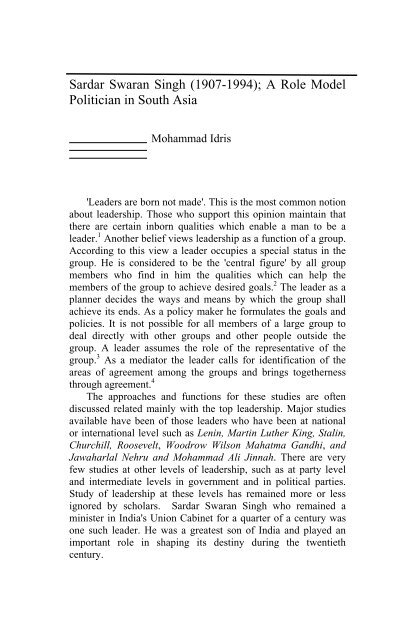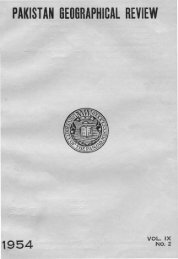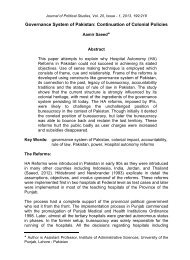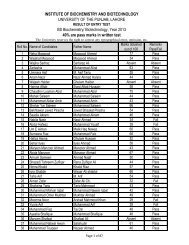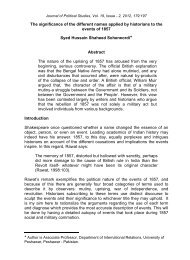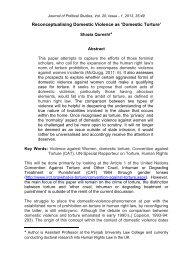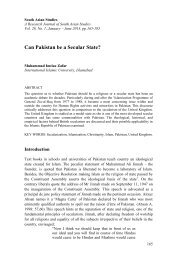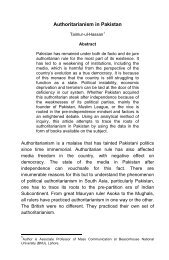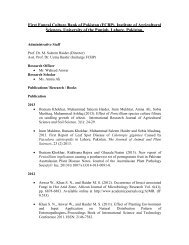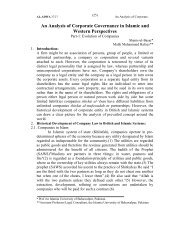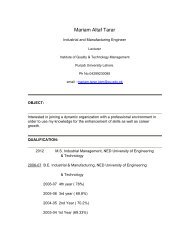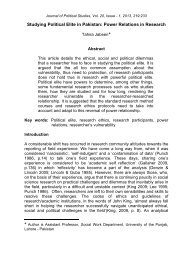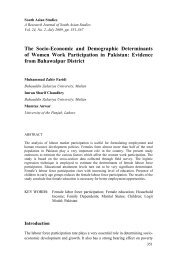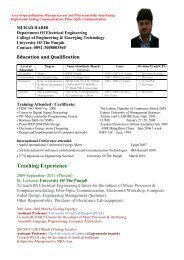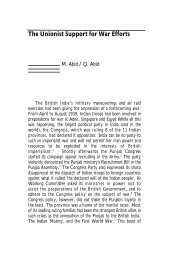Sardar Swaran Singh (1907-1994) - University of the Punjab
Sardar Swaran Singh (1907-1994) - University of the Punjab
Sardar Swaran Singh (1907-1994) - University of the Punjab
You also want an ePaper? Increase the reach of your titles
YUMPU automatically turns print PDFs into web optimized ePapers that Google loves.
<strong>Sardar</strong> <strong>Swaran</strong> <strong>Singh</strong> (<strong>1907</strong>-<strong>1994</strong>); A Role Model<br />
Politician in South Asia<br />
Mohammad Idris<br />
'Leaders are born not made'. This is <strong>the</strong> most common notion<br />
about leadership. Those who support this opinion maintain that<br />
<strong>the</strong>re are certain inborn qualities which enable a man to be a<br />
leader. 1 Ano<strong>the</strong>r belief views leadership as a function <strong>of</strong> a group.<br />
According to this view a leader occupies a special status in <strong>the</strong><br />
group. He is considered to be <strong>the</strong> 'central figure' by all group<br />
members who find in him <strong>the</strong> qualities which can help <strong>the</strong><br />
members <strong>of</strong> <strong>the</strong> group to achieve desired goals. 2 The leader as a<br />
planner decides <strong>the</strong> ways and means by which <strong>the</strong> group shall<br />
achieve its ends. As a policy maker he formulates <strong>the</strong> goals and<br />
policies. It is not possible for all members <strong>of</strong> a large group to<br />
deal directly with o<strong>the</strong>r groups and o<strong>the</strong>r people outside <strong>the</strong><br />
group. A leader assumes <strong>the</strong> role <strong>of</strong> <strong>the</strong> representative <strong>of</strong> <strong>the</strong><br />
group. 3 As a mediator <strong>the</strong> leader calls for identification <strong>of</strong> <strong>the</strong><br />
areas <strong>of</strong> agreement among <strong>the</strong> groups and brings toge<strong>the</strong>rness<br />
through agreement. 4<br />
The approaches and functions for <strong>the</strong>se studies are <strong>of</strong>ten<br />
discussed related mainly with <strong>the</strong> top leadership. Major studies<br />
available have been <strong>of</strong> those leaders who have been at national<br />
or international level such as Lenin, Martin Lu<strong>the</strong>r King, Stalin,<br />
Churchill, Roosevelt, Woodrow Wilson Mahatma Gandhi, and<br />
Jawaharlal Nehru and Mohammad Ali Jinnah. There are very<br />
few studies at o<strong>the</strong>r levels <strong>of</strong> leadership, such as at party level<br />
and intermediate levels in government and in political parties.<br />
Study <strong>of</strong> leadership at <strong>the</strong>se levels has remained more or less<br />
ignored by scholars. <strong>Sardar</strong> <strong>Swaran</strong> <strong>Singh</strong> who remained a<br />
minister in India's Union Cabinet for a quarter <strong>of</strong> a century was<br />
one such leader. He was a greatest son <strong>of</strong> India and played an<br />
important role in shaping its destiny during <strong>the</strong> twentieth<br />
century.
Pakistan Vision Vol 10 No 1 13<br />
<strong>Sardar</strong> <strong>Swaran</strong> <strong>Singh</strong> was born on 19 August, <strong>1907</strong> in<br />
Shankar Village at distance <strong>of</strong> 6 km. from Nakodar in Jalandhar<br />
district. He belonged to agricultural family. He was a prodigious<br />
child. His fa<strong>the</strong>r <strong>Sardar</strong> Pratap <strong>Singh</strong> was a prominent figure<br />
amongst <strong>the</strong> Sikhs and remained Vice-President and President <strong>of</strong><br />
Shiromani Gurudwara Prabandhak Committee, Amritsar for a<br />
number <strong>of</strong> years. After topping <strong>the</strong> matriculation examination in<br />
Jalandhar District he joined Randhir College, Kapurthala and<br />
passed Intermediate with credit. Thereafter, he joined<br />
Government College, Lahore and secured <strong>the</strong> degree <strong>of</strong> B. Sc.<br />
(Honors’) and two years later in 1930 he earned, <strong>the</strong> degree <strong>of</strong><br />
Master <strong>of</strong> Science (Physics) with distinction. Later on, he<br />
worked as a lecturer in Physics at Khalsa College, Lyallpur. But<br />
soon after leaving <strong>the</strong> job he joined <strong>the</strong> Government Law<br />
College, Lahore and passed <strong>the</strong> degree <strong>of</strong> L.L.B in 1932. He<br />
started his practice from Jalandhar and established himself as a<br />
successful advocate specializing in criminal suits. He made a<br />
mark in <strong>the</strong> pr<strong>of</strong>ession by his unique insight into <strong>the</strong> judicial<br />
process and power <strong>of</strong> argument. 5<br />
The Sikhs were divided into three groups during that period.<br />
In <strong>the</strong> first category were those who were pro-British. Their<br />
representative body was <strong>the</strong> Chief Khalsa Diwan which was<br />
chiefly dominated by <strong>the</strong> Sikh aristocracy with also having small<br />
number <strong>of</strong> educated Sikhs from <strong>the</strong> middle class in its fold. This<br />
organization did not join <strong>the</strong> Congress, nor did it support any<br />
anti-imperialist activity in <strong>Punjab</strong>. Their main object was to<br />
protect <strong>the</strong> interests <strong>of</strong> <strong>the</strong> Sikhs by aligning with <strong>the</strong> British. The<br />
second organization <strong>of</strong> <strong>the</strong> Sikhs was Central Sikh League. 6 It<br />
had a social base mainly among <strong>the</strong> educated middle class Sikhs<br />
<strong>of</strong> urban areas. They understood <strong>the</strong> real exploitative character <strong>of</strong><br />
British imperialism and <strong>the</strong>y were influenced by <strong>the</strong> growing<br />
wave <strong>of</strong> Indian nationalism. Therefore, from <strong>the</strong> very beginning,<br />
<strong>the</strong>y associated <strong>the</strong>mselves with <strong>the</strong> Congress against antiimperialism<br />
struggle in <strong>Punjab</strong>. 7<br />
The Shiromani Akali Dal, ano<strong>the</strong>r organization <strong>of</strong> <strong>the</strong> Sikhs,<br />
was constituted with a view to reform Gurudwaras by putting<br />
moral pressure. It was mainly composed <strong>of</strong> Jat Sikh peasantry,<br />
artisans, skilled and unskilled labour, soldiers etc. 8 From <strong>the</strong> very<br />
beginning this organization was deeply involved in a series <strong>of</strong><br />
struggles against British imperialism. In <strong>the</strong> course <strong>of</strong> <strong>the</strong>se
14 <strong>Sardar</strong> <strong>Swaran</strong> <strong>Singh</strong> (<strong>1907</strong>-<strong>1994</strong>)<br />
struggles <strong>the</strong>y worked sometimes alone but <strong>of</strong>ten in collaboration<br />
with <strong>the</strong> Congress. 9<br />
After 1933, <strong>Sardar</strong> <strong>Swaran</strong> <strong>Singh</strong> associated himself with<br />
socio-religious and political activities in <strong>the</strong> <strong>Punjab</strong>. He<br />
developed affinity with Akali Dal and became its prominent<br />
leader by <strong>the</strong> mid forties. Under <strong>the</strong> Government <strong>of</strong> India Act<br />
1935 <strong>the</strong> elections in <strong>the</strong> <strong>Punjab</strong> were held in <strong>the</strong> beginning <strong>of</strong><br />
1937. The Akalis, Unionists and <strong>the</strong> Congress were <strong>the</strong> major<br />
political parties contesting <strong>the</strong> elections. The Akali Dal and<br />
Congress reached on an accord for fighting <strong>the</strong> elections in<br />
alliance on 14 November 1936. 10 As a result <strong>of</strong> this Congress-<br />
Sikh unity, to a certain extent <strong>the</strong> Sikh's communal adamancy<br />
started melting, a national outlook began to emerge in him and<br />
he began to feel that service to <strong>the</strong> country was not possible in<br />
<strong>the</strong> narrow confines <strong>of</strong> <strong>the</strong> Akali Dal. The Congress was <strong>the</strong> right<br />
forum for such activity. In <strong>the</strong> election <strong>of</strong> 1937 Sikhs won 24<br />
seats, 14 were contested by Akali Dal and 10 by <strong>the</strong> Congress.<br />
Important names among <strong>the</strong> 14 members <strong>of</strong> <strong>the</strong> Akali Dal were,<br />
<strong>Sardar</strong> <strong>Swaran</strong> <strong>Singh</strong>, S. Baldev <strong>Singh</strong>, S. Partap <strong>Singh</strong> Kairon.<br />
Giani Kartar <strong>Singh</strong>, Narotam <strong>Singh</strong>, Kapoor <strong>Singh</strong> etc., most <strong>of</strong><br />
<strong>the</strong>m later on joined <strong>the</strong> Congress. 11<br />
<strong>Sardar</strong> <strong>Swaran</strong> <strong>Singh</strong> played an important role in <strong>the</strong> Akali<br />
Dal– Congress compromise. As an active member <strong>of</strong> Akali Dal<br />
he opposed <strong>the</strong> Pakistan scheme and condemned <strong>the</strong> Cripps<br />
Mission Plan <strong>of</strong> 22 March, 1942. 12 Meanwhile, <strong>the</strong> Sikhs who<br />
were not in <strong>the</strong> Congress felt <strong>the</strong> need to organize a political<br />
party distinct from <strong>the</strong> Akali Dal but having religious orientation.<br />
Therefore, <strong>the</strong> 'Panthic party' was formed just before <strong>the</strong> 1946<br />
elections. 13 <strong>Sardar</strong> Baldev <strong>Singh</strong> was elected its leader, S. Ujjal<br />
<strong>Singh</strong> and S. <strong>Swaran</strong> <strong>Singh</strong>, deputy leaders and S. Ajit <strong>Singh</strong><br />
became secretary <strong>of</strong> Panthic Party. <strong>Sardar</strong> <strong>Swaran</strong> <strong>Singh</strong> played<br />
an important role in <strong>the</strong> party. He participated in all <strong>the</strong><br />
Conferences organized by <strong>the</strong> party and worked day and night<br />
for <strong>the</strong> success <strong>of</strong> his party in <strong>the</strong> elections. 14<br />
In 1946 <strong>Sardar</strong> <strong>Swaran</strong> <strong>Singh</strong> was elected in <strong>the</strong> <strong>Punjab</strong><br />
Legislative Assembly on <strong>the</strong> Panthic Party's ticket. In <strong>the</strong> very<br />
year <strong>of</strong> his election, he became Parliamentary Secretary to <strong>the</strong><br />
<strong>Punjab</strong> Coalition Government headed by Malik Sir Khizar Hayat<br />
Khan Tiwana. 15 The Cabinet Mission plan announced its<br />
decision on 16 May 1946. It commenced an era <strong>of</strong> new
Pakistan Vision Vol 10 No 1 15<br />
controversies. Sikhs <strong>of</strong> all shades <strong>of</strong> opinion immediately<br />
rejected <strong>the</strong> Cabinet Mission's proposal in an anti-British vein,<br />
on <strong>the</strong> ground that <strong>the</strong>se would leave <strong>the</strong>m at <strong>the</strong> mercy <strong>of</strong> <strong>the</strong><br />
Muslim majority and thus deprive <strong>the</strong>m <strong>of</strong> <strong>the</strong> political<br />
advantage, <strong>the</strong>y now enjoyed and took from <strong>the</strong>m <strong>the</strong>ir lands in<br />
<strong>the</strong> <strong>Punjab</strong>, living in which was <strong>the</strong>ir birth right. 16 <strong>Swaran</strong> <strong>Singh</strong><br />
dismissed <strong>the</strong> possibility <strong>of</strong> deciding <strong>the</strong> issue on <strong>the</strong> basis <strong>of</strong> an<br />
election in <strong>the</strong>se troubled times and said <strong>the</strong>re can be no<br />
settlement on <strong>the</strong> basis <strong>of</strong> a united <strong>Punjab</strong>. 17 While talking <strong>of</strong> a<br />
divided <strong>Punjab</strong>, he continued to advise <strong>the</strong> Sikh peasantry not to<br />
migrate from <strong>the</strong>ir villages in West <strong>Punjab</strong>. 18<br />
When <strong>Sardar</strong> Baldev <strong>Singh</strong> was included in <strong>the</strong> interim<br />
Government headed by Pandit Jawaharlal Nehru, <strong>Sardar</strong> <strong>Swaran</strong><br />
<strong>Singh</strong> succeeded <strong>the</strong> former as Minister for Development and<br />
Supplies. However, in <strong>the</strong> rapidly changing political scene <strong>of</strong><br />
1946-47, Khizar Hayat Khan submitted his resignation on 1 st<br />
March, 1947. A day after Khizar made <strong>the</strong> statement <strong>of</strong> his<br />
support to <strong>the</strong> Muslim League and to any effort it might make in<br />
<strong>the</strong> formation <strong>of</strong> a government in <strong>Punjab</strong>, <strong>Swaran</strong> <strong>Singh</strong>, <strong>the</strong><br />
upcoming leader expressed his surprise and disappointment at<br />
Khizar's change <strong>of</strong> heart. 19 A few days later, <strong>the</strong> Congress party's<br />
senior leaders in <strong>Punjab</strong>, Bhim Sen Sachar and <strong>Swaran</strong> <strong>Singh</strong>,<br />
went on record saying, "We hope to see a united India again<br />
drawn toge<strong>the</strong>r by geographical and fundamental ties <strong>of</strong> common<br />
interest". He was also a front member <strong>of</strong> Anti-Partition<br />
Committee and President <strong>of</strong> <strong>the</strong> '<strong>Punjab</strong> Riot's Relief<br />
Committee'. 20<br />
The Government <strong>of</strong> <strong>the</strong> <strong>Punjab</strong> established <strong>the</strong> '<strong>Punjab</strong><br />
Partition Committee' in order to implement <strong>the</strong> decision <strong>of</strong> <strong>the</strong><br />
partition <strong>of</strong> <strong>Punjab</strong>. The <strong>Punjab</strong> Partition Committee consisted <strong>of</strong><br />
four members-two from <strong>the</strong> East <strong>Punjab</strong>, viz. Dr. Gopichand<br />
Bhargava and <strong>Sardar</strong> <strong>Swaran</strong> <strong>Singh</strong> and two members from <strong>the</strong><br />
West <strong>Punjab</strong>, viz. Mr. Mumtaz Daultana and Mr. Zahid<br />
Hussain. The Governor was <strong>the</strong> President. 21 The main function<br />
<strong>of</strong> <strong>the</strong> organization was to work out <strong>the</strong> machinery for<br />
implementing <strong>the</strong> partition. 22 <strong>Sardar</strong> <strong>Swaran</strong> <strong>Singh</strong> played an<br />
important role in <strong>the</strong> <strong>Punjab</strong> Partition Committee. Regarding <strong>the</strong><br />
posting <strong>of</strong> <strong>of</strong>fices and <strong>the</strong> location <strong>of</strong> East <strong>Punjab</strong> and West<br />
<strong>Punjab</strong> Secretariats, he raised <strong>the</strong> following points in <strong>the</strong> <strong>Punjab</strong><br />
Partition Committee meeting held on 7 July, 1947. 23 'First some
16 <strong>Sardar</strong> <strong>Swaran</strong> <strong>Singh</strong> (<strong>1907</strong>-<strong>1994</strong>)<br />
sort <strong>of</strong> agreement was necessary for <strong>the</strong> posting <strong>of</strong> <strong>of</strong>fices in <strong>the</strong><br />
districts until <strong>the</strong> declaration <strong>of</strong> <strong>the</strong> award <strong>of</strong> <strong>the</strong> <strong>Punjab</strong><br />
Boundary Commission. Second, it was necessary to reach an<br />
agreement on <strong>the</strong> continuance <strong>of</strong> <strong>the</strong> two seats <strong>of</strong> <strong>of</strong>fices <strong>of</strong> <strong>the</strong><br />
Government <strong>of</strong> <strong>the</strong> West <strong>Punjab</strong> and <strong>the</strong> East <strong>Punjab</strong> at Lahore'. 24<br />
During <strong>the</strong>se days <strong>the</strong> political situation in <strong>Punjab</strong> rapidly<br />
turned chaotic. The Governor <strong>of</strong> <strong>Punjab</strong> at that time was Sir<br />
Evan Jenkins, who had spent 17 years <strong>of</strong> his career in <strong>Punjab</strong>. 25<br />
Sir Evan Jenkins, formed a 'Security Council' in order to<br />
maintain law and order in <strong>the</strong> province. It comprised three party<br />
leaders in <strong>the</strong> Legislative Assembly, viz. Khan Iftikhar Hussain<br />
<strong>of</strong> Mamdot, <strong>the</strong> leader <strong>of</strong> <strong>the</strong> Muslim League Assembly Party,<br />
Bhim Sen Sacher, leader <strong>of</strong> <strong>the</strong> Congress party, and <strong>Sardar</strong><br />
<strong>Swaran</strong> <strong>Singh</strong>, leader <strong>of</strong> <strong>the</strong> Akali party. It met daily to review<br />
<strong>the</strong> law-and-order situation in <strong>Punjab</strong> and more particularly in<br />
Lahore. 26 But this Security Council could not work, as <strong>the</strong><br />
Muslim League withdrew its representative from <strong>the</strong> Council. 27<br />
During <strong>the</strong>se days <strong>Sardar</strong> <strong>Swaran</strong> <strong>Singh</strong> became very close to Sir<br />
Even Jenkins. He did his best for <strong>the</strong> functioning <strong>of</strong> <strong>the</strong> Security<br />
Council.<br />
The Mountbatten plan <strong>of</strong> 3rd June 1947 suggested <strong>the</strong><br />
division <strong>of</strong> <strong>Punjab</strong>, which had been included in <strong>the</strong> Indian<br />
Independence Act, 1947. Before 15 August, 1947 <strong>the</strong> communal<br />
riots in <strong>the</strong> <strong>Punjab</strong> took <strong>the</strong> worst turn in some <strong>of</strong> <strong>the</strong> districts<br />
where <strong>the</strong>re were British Deputy Commissioners. These districts<br />
were Rawalpindi, Multan, Lahore, and Amritsar. 28 Pandit<br />
Jawaharlal Nehru, <strong>the</strong>refore stated, "In <strong>Punjab</strong> <strong>the</strong>re was cent per<br />
cent British rule, despite <strong>the</strong> efforts <strong>of</strong> certain senior <strong>of</strong>ficers<br />
murder and arson continued". The trouble was prevalent most<br />
where <strong>the</strong>re were British <strong>of</strong>ficers in charge and <strong>the</strong> divisions<br />
under <strong>the</strong> control <strong>of</strong> ei<strong>the</strong>r Hindu or Muslim <strong>of</strong>ficers were<br />
comparatively quiet. 29 On 26 June Lahore saw unprecedented<br />
scenes in <strong>the</strong> Town Hall. Mayor Main Amiruddin presided over a<br />
meeting which included not only every councilor <strong>of</strong> <strong>the</strong> city but<br />
also leaders from all <strong>the</strong> political Parties. While Congress leader<br />
Bhim Sen Sachar appealed to everyone to take up <strong>the</strong> peace<br />
initiative, <strong>Swaran</strong> <strong>Singh</strong> said <strong>the</strong> need was to change people's<br />
mentality which had been poisoned by <strong>the</strong> long drawn strife'. The<br />
following day, 'Dawn' commented in its editorial on <strong>the</strong>
Pakistan Vision Vol 10 No 1 17<br />
proceedings <strong>of</strong> this important meeting and said that it was good<br />
that leaders like <strong>Sardar</strong> <strong>Swaran</strong> <strong>Singh</strong> had joined <strong>the</strong> appeal. 30<br />
The composition <strong>of</strong> <strong>the</strong> <strong>Punjab</strong> Boundary Commission had<br />
been announced on 30 June 1947. The joint Memorandum <strong>of</strong> <strong>the</strong><br />
Sikhs to <strong>the</strong> <strong>Punjab</strong> Boundary Commission was argued by<br />
Harnam <strong>Singh</strong> and ran into 75 pages. 31 In <strong>the</strong> memorandum<br />
major emphasis was laid on ignoring religions sentiments, land<br />
ownership, banking and factories as for as <strong>the</strong> question <strong>of</strong><br />
partition was concerned. It was also argued that <strong>the</strong> plan would<br />
deprive East <strong>Punjab</strong> not only <strong>of</strong> <strong>the</strong> major food growing areas<br />
but also <strong>of</strong> most <strong>of</strong> <strong>the</strong> water for irrigation. 32 <strong>Sardar</strong> <strong>Swaran</strong> was<br />
closely associated with <strong>the</strong> preparation <strong>of</strong> <strong>the</strong> Memorandum and<br />
<strong>the</strong> East <strong>Punjab</strong>'s case before <strong>the</strong> Radcliff Boundary<br />
Commission.<br />
The partition <strong>of</strong> <strong>Punjab</strong> enforced movements <strong>of</strong> <strong>the</strong> people<br />
on a scale absolutely unparalleled in <strong>the</strong> history <strong>of</strong> <strong>the</strong> world. 33<br />
Unlike <strong>the</strong> transfer <strong>of</strong> population in <strong>the</strong> European Countries, <strong>the</strong><br />
mass migration in <strong>the</strong> East <strong>Punjab</strong> and <strong>the</strong> West <strong>Punjab</strong> did not<br />
result from any settled Government policy. The cross migration<br />
<strong>of</strong> <strong>the</strong> population created a number <strong>of</strong> problems for both <strong>the</strong><br />
newly born states. The refugees were concentrated in a very<br />
large number on both sides <strong>of</strong> <strong>the</strong> border. 34 Both <strong>the</strong> Central<br />
Governments <strong>of</strong> India and Pakistan and provincial Governments<br />
<strong>of</strong> <strong>the</strong> East <strong>Punjab</strong> and West <strong>Punjab</strong> had to open Rehabilitation<br />
Departments for reception, care and rehabilitation <strong>of</strong> refugees.<br />
The Sikhs and <strong>the</strong> Hindus had left extensive areas <strong>of</strong> agricultural<br />
land which <strong>the</strong>y had owned or tilled as tenants in West <strong>Punjab</strong>.<br />
All <strong>of</strong> that agricultural land was not available for rehabilitation<br />
<strong>of</strong> refugees as many <strong>of</strong> <strong>the</strong> evacuee land-lords had rented <strong>the</strong>ir<br />
land to Muslim tenants. 35 The Government on both sides could<br />
do little but admit, as an <strong>of</strong>ficial statement that <strong>the</strong>re were<br />
dastardly attacks on <strong>the</strong> trains.<br />
The communal riots <strong>of</strong> March, 1947 unnerved <strong>the</strong> Sikhs and<br />
Hindus because <strong>the</strong> Sikh and <strong>the</strong> Hindu population <strong>of</strong> several<br />
villages had been wiped out. 36 This convinced <strong>the</strong> Sikhs that it<br />
would be impossible for <strong>the</strong>m to live safely in <strong>the</strong> Muslim<br />
majority areas likely to be included in Pakistan. It was on this<br />
account that a joint meeting <strong>of</strong> <strong>the</strong> 'Panthic Assembly Party', <strong>the</strong><br />
working committee <strong>of</strong> <strong>the</strong> Shiromani Akali Dal and <strong>the</strong> 'Panthic<br />
Pratinidi Board' Passed a resolution on <strong>the</strong> 11 th June, 1947 at
18 <strong>Sardar</strong> <strong>Swaran</strong> <strong>Singh</strong> (<strong>1907</strong>-<strong>1994</strong>)<br />
New Delhi 37 to effect that, The Boundary Commission should<br />
be given express directions to make recommendations for <strong>the</strong><br />
transfer <strong>of</strong> <strong>the</strong> Hindu and Sikh population and property from <strong>the</strong><br />
Western part <strong>of</strong> <strong>Punjab</strong> to <strong>the</strong> Eastern part after <strong>the</strong> partition had<br />
been effected on an equitable basis. 38 This conference<br />
apprehended that in <strong>the</strong> absence <strong>of</strong> provision <strong>of</strong> transfer <strong>of</strong><br />
population and property <strong>the</strong> very purpose <strong>of</strong> partition would be<br />
defeated. <strong>Sardar</strong> <strong>Swaran</strong> <strong>Singh</strong> also attended <strong>the</strong> conference as<br />
<strong>the</strong> elected president <strong>of</strong> <strong>the</strong> '<strong>Punjab</strong> Riot's Relief Committee'. 39<br />
He left Lahore on <strong>the</strong> morning <strong>of</strong> 14 th August.1947<br />
15 August 1947, <strong>the</strong> fateful day arrived. In obedience to <strong>the</strong><br />
order for illuminations, flag hoisting and feasting while <strong>Punjab</strong><br />
was pr<strong>of</strong>usely bleeding......but no sooner was <strong>the</strong> order given that<br />
it was countermanded. The East <strong>Punjab</strong> government....realized<br />
<strong>the</strong> enormity <strong>of</strong> <strong>the</strong> crime <strong>the</strong>y would be committing against <strong>the</strong>ir<br />
own people by adhering to this programme. 40 On <strong>the</strong> same day<br />
<strong>Swaran</strong> <strong>Singh</strong> was sworn as Home Minister in <strong>the</strong> Cabinet <strong>of</strong><br />
Indian <strong>Punjab</strong> led by Dr. Gopi Chand Bhargava. In <strong>the</strong> beginning<br />
<strong>the</strong> Cabinet had only two member’s viz. Gopichand Bhargava<br />
and S. <strong>Swaran</strong>. At that time <strong>the</strong> main objective was to make East<br />
<strong>Punjab</strong> stand on its own legs. The Capital was shifted to Shimla<br />
and created temporary Secretariat at Jalandhar.<br />
On 18 Auguast 1947, with <strong>the</strong> efforts <strong>of</strong> <strong>Sardar</strong> <strong>Swaran</strong><br />
<strong>Singh</strong> a joint statement by ministers <strong>of</strong> <strong>the</strong> East and West <strong>Punjab</strong><br />
signed by <strong>Sardar</strong> <strong>Swaran</strong> <strong>Singh</strong>, Dr. Gopichand Bhargava,<br />
Karmat Ali and Khan Iftikhar Hussain Nawab <strong>of</strong> Mamdot was<br />
also carried prominently by most newspapers on 19-20 August,<br />
"We have set up machinery for <strong>the</strong> closest operation.....we<br />
appeal to all to let old wounds heal.....help in <strong>the</strong> establishment<br />
<strong>of</strong> Peace and Security. Peace in one part <strong>of</strong> <strong>the</strong> province is linked<br />
with peace in <strong>the</strong> o<strong>the</strong>r." 41<br />
About <strong>the</strong> end <strong>of</strong> November an un<strong>of</strong>ficial policy <strong>of</strong><br />
discouraging as for as possible <strong>the</strong> entry <strong>of</strong> Sikhs into West<br />
<strong>Punjab</strong> was pursued that <strong>the</strong> Pakistan authorities had turned<br />
down <strong>the</strong> request <strong>of</strong> <strong>the</strong> government <strong>of</strong> India to permit Sikhs to<br />
visit <strong>the</strong> holy shrine <strong>of</strong> Nankana Sahib on Guru Nanak's birthday,<br />
26 November. 42 The Sikhs had been advised by <strong>the</strong> government<br />
<strong>of</strong> India not to visit Nanakana Sahib. 43 <strong>Sardar</strong> <strong>Swaran</strong> <strong>Singh</strong> <strong>the</strong><br />
East <strong>Punjab</strong> Home Minister, however had been allowed to visit<br />
Nankana Sahib. He visited <strong>the</strong> shrine <strong>of</strong> Guru Nanak Dev along
Pakistan Vision Vol 10 No 1 19<br />
with Ahsanuddin, <strong>the</strong> Commissioner, and Refugee Minister in<br />
<strong>the</strong> West <strong>Punjab</strong>. <strong>Swaran</strong> <strong>Singh</strong> later said he was satisfied with<br />
<strong>the</strong> upkeep <strong>of</strong> <strong>the</strong> shrine. 44 During those chaotic days <strong>of</strong> utter<br />
desolation and confusion when an orgy <strong>of</strong> bloodshed and<br />
destruction had overtaken <strong>the</strong> <strong>Punjab</strong> and millions <strong>of</strong> uprooted<br />
and destitute refugees had poured in from across <strong>the</strong> border, <strong>the</strong><br />
task <strong>of</strong> restoring peace, ensuring security and providing shelter<br />
and was indeed a challenging one. This assignment was tackled<br />
with great success by <strong>Singh</strong>. 45<br />
<strong>Swaran</strong> <strong>Singh</strong> was elected to <strong>the</strong> <strong>Punjab</strong> Legislative<br />
Assembly during <strong>the</strong> General elections <strong>of</strong> 1952 as a nominee <strong>of</strong><br />
<strong>the</strong> Congress with which he had became associated in <strong>the</strong> latter<br />
half <strong>of</strong> 1946, and became Minister for Capital Projects and<br />
Electricity in Bhim Sen Sachar's Cabinet. 13 th May1952 he<br />
resigned Ministry <strong>of</strong> <strong>Punjab</strong> when Pandit Jawaharlal Nehru<br />
included him <strong>the</strong> Central Cabinet 1952-1957. He was elected to<br />
<strong>the</strong> Lok Sabha in 1957,1962,1967,1972.<br />
Generally, <strong>Swaran</strong> <strong>Singh</strong> is remembered as former External<br />
Affairs Minister, but he held charge <strong>of</strong> many o<strong>the</strong>r important<br />
departments like Works, Housing and Supplies (1952-57), Steal<br />
Mines and Fuel (1957-62), Agriculture (1962), Railways (1962),<br />
1963, External Affairs (1964-66), Defense (1966-70) and again<br />
External Affairs (1970-74) and Defense (1974-76). He<br />
represented India at a number <strong>of</strong> international conferences. Often<br />
described as <strong>the</strong> roving ambassador <strong>of</strong> India, <strong>Sardar</strong> <strong>Swaran</strong><br />
<strong>Singh</strong> had been part <strong>of</strong> many a historic decisions and events. He<br />
led <strong>the</strong> Indian delegation to <strong>the</strong> United Nations General<br />
Assembly and Security Council more than ten times. He<br />
represented India at <strong>the</strong> Indo-Pakistan Conference on Border<br />
problems in 1959-60. He was among <strong>the</strong> advisers <strong>of</strong> Jawaharlal<br />
Nehru on <strong>the</strong> India-China border dispute and represented <strong>the</strong><br />
country at talks preceding <strong>the</strong> signing <strong>of</strong> <strong>the</strong> Inter-Dominion<br />
Agreement between <strong>the</strong> Government <strong>of</strong> India and Pakistan on<br />
<strong>the</strong> canal water dispute between East <strong>Punjab</strong> and West <strong>Punjab</strong> on<br />
4 th May 1948. Again he signed a treaty with Pakistan on behalf<br />
<strong>of</strong> India on 8 th May 1954 after <strong>the</strong> conference <strong>of</strong> India-Pakistan<br />
on <strong>the</strong> recovery <strong>of</strong> abducted persons, held in New Delhi. 46<br />
<strong>Swaran</strong> <strong>Singh</strong> also led <strong>the</strong> Indian delegation for talks on<br />
Kashmir and border problems with Pakistan in 1960. These talks<br />
were noted for <strong>the</strong> degree <strong>of</strong> cordiality in which <strong>the</strong>y took place
20 <strong>Sardar</strong> <strong>Swaran</strong> <strong>Singh</strong> (<strong>1907</strong>-<strong>1994</strong>)<br />
largely with <strong>the</strong> help <strong>of</strong> S. <strong>Swaran</strong> <strong>Singh</strong>. 47 On Nehru's death in<br />
1964, Lal Bhahdur Shastri moved him to <strong>the</strong> Ministry <strong>of</strong><br />
External Affairs; he became <strong>the</strong> first Indian o<strong>the</strong>r than a Prime<br />
Minister, to hold independent charge <strong>of</strong> <strong>the</strong> Foreign Affairs<br />
portfolio. He quickly established his reputation as a skilled and<br />
tough international negotiator. 48<br />
Diligence, modesty and simplicity were <strong>the</strong> hallmarks <strong>of</strong><br />
<strong>Swaran</strong> <strong>Singh</strong>'s personality. He never allowed malice or anger to<br />
rule him but always maintained a calm and courteous demeanor.<br />
Unflappability was one <strong>of</strong> <strong>Swaran</strong> <strong>Singh</strong>'s principal assets in<br />
negotiation. 49<br />
Lee Kuon Yew, Prime Minister <strong>of</strong> Singapore complemented<br />
him for his performance at <strong>the</strong> Commonwealth Prime Ministers<br />
conference in Singapore in 1971 where <strong>Swaran</strong> <strong>Singh</strong><br />
represented Indira Gandhi. 50<br />
A few days after <strong>the</strong> end <strong>of</strong> <strong>the</strong> Commonwealth Prime<br />
Ministers Conference, Lee Kuon Yew remarked that Mr. <strong>Singh</strong><br />
carried a slab <strong>of</strong> ice under his traditional headgear. 51 It was a<br />
compliment to <strong>Swaran</strong> <strong>Singh</strong>'s cool and ruffled temper. On 12<br />
December 1971, while <strong>the</strong> Bangladesh War went on, he<br />
addressed <strong>the</strong> United Nations Security Council for an hour and a<br />
half. He called on <strong>the</strong> world to recognize '<strong>the</strong> realty <strong>of</strong><br />
Bangladesh'. 52 His speech was a masterly performance which<br />
only a person fully confident <strong>of</strong> his capacity to make a telling<br />
retort could have delivered without notice.<br />
Distinguished by his white turban, achkan, and knee length<br />
Nehru jacket, <strong>Swaran</strong> <strong>Singh</strong> as Foreign Minister was one <strong>of</strong> <strong>the</strong><br />
architects <strong>of</strong> <strong>the</strong> historic Indo-Soviet Treaty <strong>of</strong> Peace and<br />
Friendship and Co-operation in 1971 and <strong>of</strong> <strong>the</strong> Shimla<br />
agreement. The former treaty was a masterstroke <strong>of</strong> diplomacy<br />
intended to neutralize <strong>the</strong> United States. 53<br />
During <strong>the</strong> Cold War Years, India was firmly in <strong>the</strong> Soviet<br />
Camp, refusing even to condemn Moscow for its occupation <strong>of</strong><br />
Afghanistan. In exchange India was provided with arms and<br />
diplomatic succor, both <strong>of</strong> which <strong>Singh</strong> negotiated at Moscow. 54<br />
He also played an important role in bringing Shimla summit to a<br />
successful conclusion.<br />
<strong>Swaran</strong> <strong>Singh</strong> worked in <strong>the</strong> Cabinets <strong>of</strong> Jawaharlal Nehru,<br />
Lal Bhahdur Shastri and Indira Gandhi from 1952-1975.<br />
Following <strong>the</strong> promulgation <strong>of</strong> internal emergency in June 1975,
Pakistan Vision Vol 10 No 1 21<br />
<strong>Swaran</strong> <strong>Singh</strong> was entrusted with <strong>the</strong> task <strong>of</strong> suggesting<br />
constitutional reforms incorporating <strong>the</strong> socio-economic<br />
philosophy <strong>of</strong> Mrs. Gandhi's 20 point programme. The <strong>Swaran</strong><br />
<strong>Singh</strong> Committee, in its report submitted in May 1976, suggested<br />
that <strong>the</strong> declaration <strong>of</strong> Emergency by <strong>the</strong> President need not to be<br />
countrywide. It could be made applicable to a particular part <strong>of</strong><br />
<strong>the</strong> country also. The Committee also recommended eight-point<br />
code statutory duties for citizens. Some <strong>of</strong> its recommendations<br />
were later incorporated in <strong>the</strong> 42 nd Constitutional Amendment. 55<br />
In 1975 he resigned following differences with Mrs. Gandhi. He<br />
remained a member <strong>of</strong> <strong>the</strong> Parliament until 1977. He was elected<br />
president <strong>of</strong> Indian National Congress twice, in 1969 and 1978. 56<br />
<strong>Swaran</strong> <strong>Singh</strong> was a brilliant debater never dropping a point<br />
in polemics. He was a cool-headed and adroit negotiator and<br />
familiar with several languages, viz. English, <strong>Punjab</strong>i, Hindi,<br />
Urdu etc. 57 He was also India's most traveled Minister. He<br />
traveled to U.S.A., England, Canada, France, Germany, Portugal,<br />
South Africa, Iran, Iraq, Senegal, Sweden, Pakistan, and Saudi<br />
Arabia. He was sent to hold talks with <strong>the</strong> Pakistani President,<br />
General Mohammad Zia-ul-Haq following <strong>the</strong> Soviet Union's<br />
occupation <strong>of</strong> Afghanistan in 1979. In 1982, much to <strong>the</strong> surprise<br />
<strong>of</strong> <strong>the</strong> <strong>the</strong>n Foreign Ministry <strong>of</strong> India, Mrs. Gandhi requested<br />
<strong>Swaran</strong> <strong>Singh</strong>’s presence at Non-Aligned Summit in New Delhi.<br />
"He is a useful man to have around", she said, "He never gets<br />
into a flap." 58<br />
Over a decade after he retired from public life he was India's<br />
nominee to 'Eminent Persons Group' from Commonwealth<br />
Countries which visited South Africa in 1986; he was <strong>the</strong> first<br />
Indian to visit Nelson Mandela in <strong>the</strong> prison. The o<strong>the</strong>r three<br />
members <strong>of</strong> eminent persons group were former Australian<br />
Prime Minister Malcolm Fraser, Former British Chancellor <strong>of</strong><br />
Exchequer Lord Barber and Former Canadian Prime Minister<br />
Pierre Trudeau. His services were also utilized to solve <strong>the</strong><br />
<strong>Punjab</strong> crisis and he met Akali leaders several times to explain<br />
<strong>the</strong> Government's point <strong>of</strong> view and impress upon <strong>the</strong> desirability<br />
<strong>of</strong> a negotiated settlement. 60 He died on 30 October <strong>1994</strong><br />
following a cardiac arrest at <strong>the</strong> age <strong>of</strong> 87. He was one <strong>of</strong> <strong>the</strong><br />
eminent figures in Indian politics who distinguished himself in<br />
every position he occupied by his exceptional competence and<br />
high integrity, particularly in <strong>the</strong> conduct <strong>of</strong> India 's foreign
22 <strong>Sardar</strong> <strong>Swaran</strong> <strong>Singh</strong> (<strong>1907</strong>-<strong>1994</strong>)<br />
policy. 61 It is to <strong>Swaran</strong> <strong>Singh</strong>'s credit that after assuming high<br />
distinction as a External Affairs Minister he had taken several<br />
steps to improve India's relations with neighboring countries. He<br />
was one <strong>of</strong> <strong>the</strong> distinguished leaders <strong>of</strong> post-Independence India.<br />
He was a man <strong>of</strong> great wisdom and dignity and his services to<br />
<strong>the</strong> nation in several important capacities over a half a century<br />
will be long remembered. 62<br />
<strong>Swaran</strong> <strong>Singh</strong> was a leader <strong>of</strong> <strong>the</strong> international caliber. 63<br />
Different kind <strong>of</strong> leadership role he appeared significant not only<br />
in <strong>the</strong> politics <strong>of</strong> South Asian countries but also at <strong>the</strong><br />
international level. He was a thorough gentleman-too much, no<br />
doubt, to succeed as a politician. He was <strong>the</strong> last <strong>of</strong> his kind. 64<br />
Notes and References<br />
1. John Adhair, Training for Leadership, MacDonald and<br />
Jane's publications, London, 1968, p. 11.<br />
2. Shiv Rattan Mehta, Emerging Pattern <strong>of</strong> Rural<br />
Leadership, Willy Eastern Publications, New Delhi,<br />
1972, p. 3.<br />
3. David Kerch and Richard Crutchfield, Theory and<br />
Problems <strong>of</strong> Social Psychology, Tata McGraw Hill<br />
Publishing, Bombay, 1948, p. 418.<br />
4. L.P. Vidyarthi, ed., Leadership in India, Asia<br />
Publishing House, Bombay, 1967, p. 58.<br />
5. Harbans <strong>Singh</strong>, ed., Encyclopaedia <strong>of</strong> Sikhism, Patiala,<br />
1998, Vol. IV, p. 30.<br />
6. K.L. Tuteja, Sikh Politics : 1920-40, Vishal<br />
Publications, Kurukshetra, 1984, p. 11.<br />
7. Teja <strong>Singh</strong>, The Gurudwara Reform Movement and<br />
Sikh Awakening, Jullundhur, 1922, p. 80.<br />
8. Home Political Affairs, File 459/11/1922.
Pakistan Vision Vol 10 No 1 23<br />
9. Raghbir <strong>Singh</strong>, Akali Movement, 1926-1947, Om sons’<br />
publications, Delhi, 1997, p. 160.<br />
10. The Akali Patrika, 18 November, 1936.<br />
11. Kshitish, Storm in <strong>Punjab</strong>, The World Publications,<br />
New Delhi, 1985, p. 97.<br />
12. Raghbir <strong>Singh</strong>, Akali Movement, 1926-1947, p. 115.<br />
13. Mahesh Inder <strong>Singh</strong>, Demand <strong>of</strong> Pakistan and<br />
Communal Pitch in <strong>Punjab</strong>, 1940-47, The <strong>Punjab</strong> Past<br />
and Present, Patiala, Vol. 1, October. 11, 1985, p. 254.<br />
14. Bhagwan Josh, Communist Movement in <strong>Punjab</strong>,<br />
1926-47, Concept Publishing House, Delhi, 1979, p.<br />
197.<br />
15. Ibid., 198.<br />
16. Confidential Report on <strong>the</strong> Situation in <strong>the</strong> <strong>Punjab</strong> <strong>the</strong><br />
Second half <strong>of</strong> May, 1946. National Archives, New<br />
Delhi.<br />
17. The Civil and Military Gazzettee, Lahore, 8 April,<br />
1947.<br />
18. Ibid., 23 April,1947.<br />
19. Ibid., 14 May, 1947.<br />
20. IORL/11/665 Information Fortnightly Appreciation,<br />
18 June 1947, No. 4717.<br />
21. Kirpal <strong>Singh</strong>, The Partition <strong>of</strong> <strong>the</strong> <strong>Punjab</strong>, Publication<br />
Bureau, <strong>Punjab</strong>i <strong>University</strong>, Patiala, 1989, p. 54.<br />
22. Partition Proceedings, Government <strong>of</strong> India, National<br />
Archives, New Delhi, Vol. I, p. 33.
24 <strong>Sardar</strong> <strong>Swaran</strong> <strong>Singh</strong> (<strong>1907</strong>-<strong>1994</strong>)<br />
23. Kirpal <strong>Singh</strong>, The Partition <strong>of</strong> <strong>the</strong> <strong>Punjab</strong>, p. 54<br />
24. Ibid., p. 60<br />
25. The Press Communique issued by J.C. Bruce <strong>of</strong><br />
Lahore Command, C&M, 3 rd June, 1947.<br />
26. Kirpal <strong>Singh</strong>, The Partition <strong>of</strong> <strong>the</strong> <strong>Punjab</strong>, p. 44.<br />
27. Partition Proceedings, Government <strong>of</strong> India, vol. IV,<br />
p. 186.<br />
28. Ibid., p. 118.<br />
29. D.R. Bose, ed., New India Speaks, speeches <strong>of</strong> Pandit<br />
Nehru, 1947, Delhi, p. 162.<br />
30. Dawn, Lahore, 27 June, 1947.<br />
31. Pakistan Times, Lahore, 26 July, 1947.<br />
32. Hindustan Times, 4 August, 1947.<br />
33. O.H.K. Spate, India and Pakistan, London, 1954, p.<br />
110.<br />
34. Kirpal <strong>Singh</strong>, The Partition <strong>of</strong> The <strong>Punjab</strong>, p. 180.<br />
35. Ibid., p.181<br />
36. Raghuvendra Tanwar, Reporting <strong>the</strong> Partition <strong>of</strong><br />
<strong>Punjab</strong> 1947, Press Public and O<strong>the</strong>r Opinions,<br />
Manohar Publishers & Distributors, New Delhi, 2006,<br />
p. 345.<br />
37. Kirpal <strong>Singh</strong>, The Partition <strong>of</strong> The <strong>Punjab</strong>, p. 144.<br />
38. The Civil and Military Gazzettee, Lahore, 15 June,<br />
1947.
Pakistan Vision Vol 10 No 1 25<br />
39. Ibid.<br />
40. Bali, A.N., Now It can Be Told, Jullundur, 1949,<br />
p. 37.<br />
41. The Hindustan Times, Delhi, 19 August, 1947.<br />
42. The Civil and Military Gazzettee, 25 November, 1947.<br />
43. Dawn, Lahore, 26 November, 1947.<br />
44. Civil and Military Gazzetee, Lahore, 29 November,<br />
1947.<br />
45. Trilochan <strong>Singh</strong>, The Beas, Jalandhar, 2004, p. V.<br />
46. The Tribune, Chandigarh, 31 October, <strong>1994</strong>.<br />
47. The Guardian, Thursday, 3 November, <strong>1994</strong>.<br />
48. The New York Times, 2 November, <strong>1994</strong>.<br />
49. Ibid.<br />
50. The Independent, Wednesday, 20 November, <strong>1994</strong>.<br />
51. The Tribune, Chandigarh, 18 October, 1974.<br />
52. The Independent, 20 November <strong>1994</strong><br />
53. The New York Times, 2 November <strong>1994</strong><br />
54. The Independent, 20 November, <strong>1994</strong><br />
55. Ibid.<br />
56. The Tribune, Chandigarh, 31 October, <strong>1994</strong>.<br />
57. Rafiq Zakaria, ed., 100 Glorious Years, Tata Press,<br />
New Delhi, 1985, p. 344.
26 <strong>Sardar</strong> <strong>Swaran</strong> <strong>Singh</strong> (<strong>1907</strong>-<strong>1994</strong>)<br />
58. Harbans <strong>Singh</strong>, Encyclopedia <strong>of</strong> Sikhism, p. 31.<br />
59. The Indpendent,20 November, <strong>1994</strong><br />
60. San Jose Mercury News, 10 November, 1985.<br />
61. The Statesman, Delhi, 1 November, <strong>1994</strong>.<br />
62. The Hindu, Delhi, 31 October, <strong>1994</strong>.<br />
63. Dr. Karan <strong>Singh</strong>, Chairman Indian Council for<br />
Cultural Relations and Former Minister in his<br />
Interview, 21 December, 2006, New Delhi with writer.<br />
64. The Guardian, Thursday, 3 November, <strong>1994</strong>.


